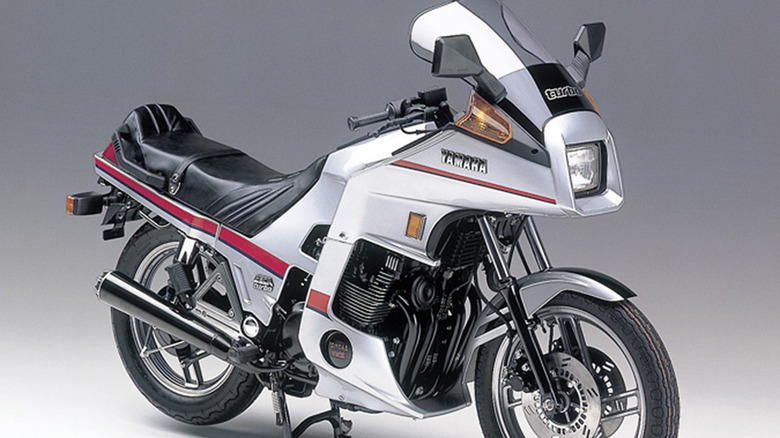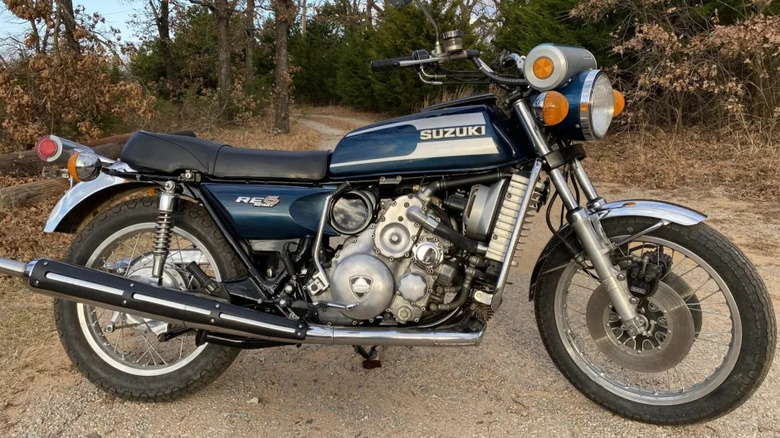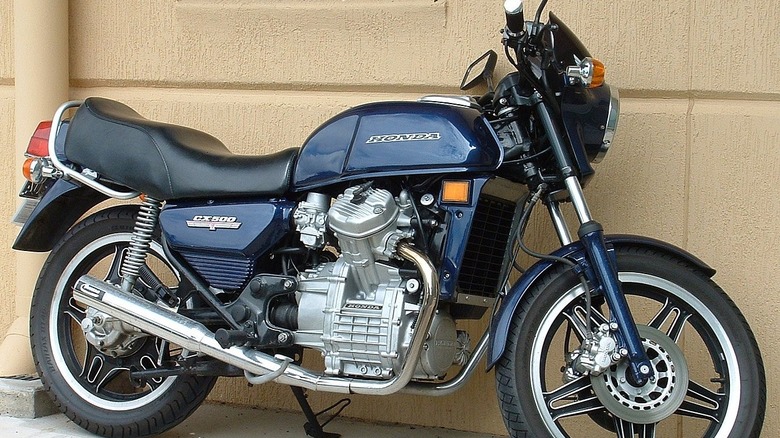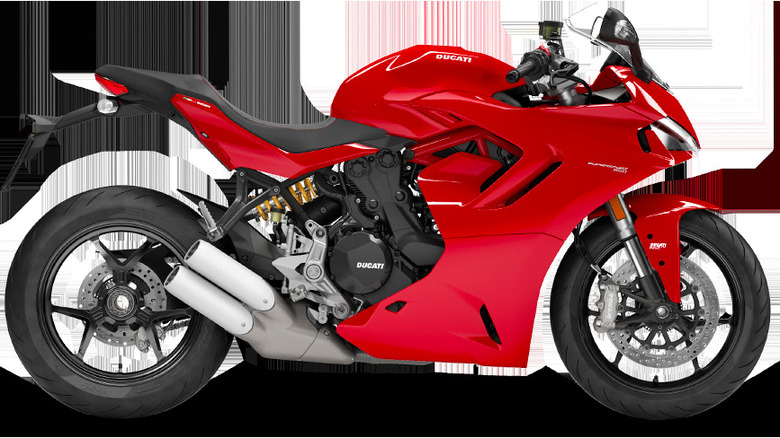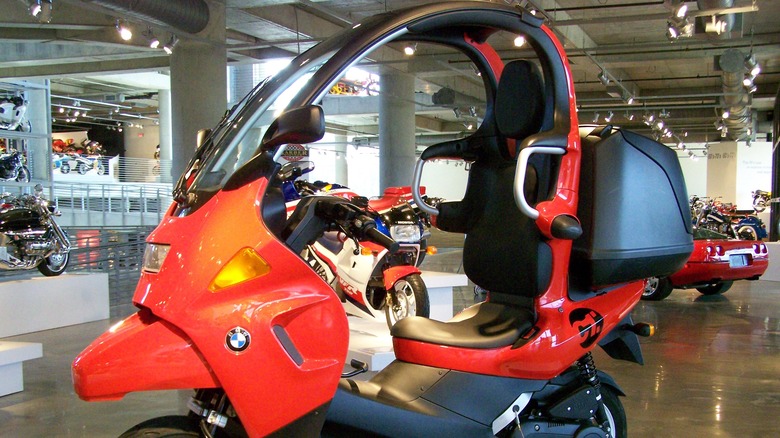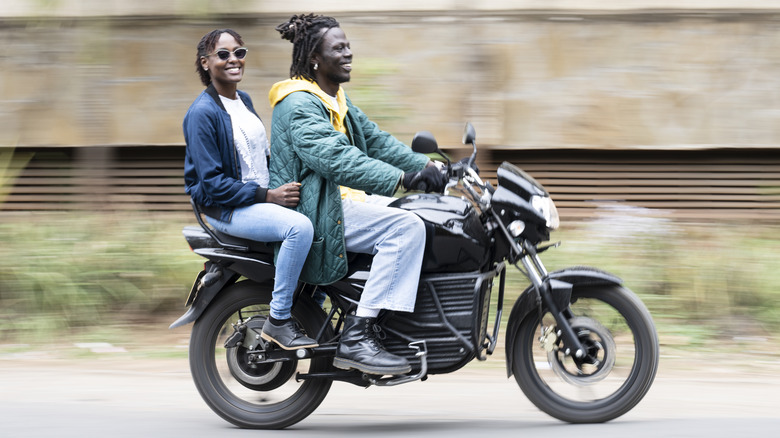5 Motorcycle Innovations That Were Just Downright Terrible
While the chronicles of motor vehicle history feature remarkable developments, such as the automatic transmission patented by Alfred Horner Munro a century ago, there have also been notable missteps. For example, the Tucker Model 48's third headlight, the DeLorean's troublesome gullwing doors, and pretty much everything about the notoriously junky Trabant 601.
As far as motorcycles go, there have been countless innovations of the two-wheeled vehicles since Gottlieb Daimler and Wilhelm Maybach patented the Daimler Reitwagen in 1885. Not all of those adaptations to Daimler and Maybach's original designs have been brilliant, though; some could be considered downright foolish. While some of those so-called improvements were made in the name of performance and others were attempts at making a particular motorcycle model safer or easier to ride, many of these design inspirations had the opposite of their intended effect. Let's take a look at five of the most misguided innovations in the nearly 150 years of motorcycle development.
Rotary Engines
Although nearly every automobile and motorcycle manufacturer has used a piston engine in all of its vehicles, Mazda tried out Felix Wankel's rotary engine design from 1967 through 1995. While Mazda was playing around with the idea of the rotary engine, a handful of motorcycle manufacturers also tried to adapt the technology to two-wheeled vehicles.
Suzuki's RE5 is probably the most well-known model that came out of those efforts, and a few of the mass-produced bikes still survive today. The single-rotor 497cc RE5 put out 62 horsepower and did not sell well after its introduction in 1974.
Around that time, the British manufacturer Norton began experimenting with rotary engine-powered motorcycles as well; its first Wankel-propelled bike was the police-issue Interpol II, which hit the streets in 1984. Norton followed that up with four civilian-issue rotary models: the Classic in 1987, the Commander in 1989, the F1 in 1990, and the F1 Sport in 1991.
However, the same flaws that doomed rotary engines to the scrap heap of automotive history made them impractical for motorcycle manufacturers. Sealing the rotor tips from fluid leaks is impossible, meaning the engines burn lots of oil and are less fuel-efficient and emissions-friendly than piston engines.
Turbochargers
Automobile manufacturers fell in love with forced induction technology in the 1980s when they discovered that turbochargers and superchargers could provide a performance boost. Although motorcycle makers had no such dilemma, they also fell victim to the siren song of the turbo's whine, and several Japanese manufacturers added turbochargers to their bikes during that period.
The first turbocharged motorcycle was the Kawasaki Z1R Turbo, manufactured in 1978 and 1979. Yamaha soon followed with the 1982 XJ650 T. Yamaha failed mightily in their design of this bike, most notably with the placement of the turbocharger. It was located between the engine and rear wheel, where it stayed warm from engine heat, and so could not operate efficiently. The turbocharger was also poorly ventilated, exacerbating the problems caused by the poor placement.
Another early turbo bike was the 1982 Honda CX500. Honda's turbo offering put out 82 horsepower to the XJ650T's 90 horsepower but did not suffer the overheating problems of the Yamaha. Suzuki was next to try producing a turbocharged motorcycle with the XN85, a 673cc model it produced until the 1988 model year. Setting aside the unfortunate design issues specific to the Yamaha, turbochargers were not a good fit for most motorcycles, mainly because of the phenomenon known as turbo lag. Manufacturers soon realized that putting a larger naturally aspirated engine in their bikes was the way to go, and fortunately, the turbo motorcycle age was a short one.
[Featured image by Bernard S. Jansen via Wikimedia Commons | Cropped and scaled | CC-BY-SA-2.5]
Single-sided swing arms
The single-sided swing arm is hardly a modern innovation — James Motorcycles debuted the design at the Stanley Show in 1908. Present-day manufacturers like Honda and BMW primarily adopted the design to make it easier to quickly change rear wheels during races without disturbing the bike's alignment or balance. Italian racing juggernaut Ducati uses the single-sided design on its Super Sport 950, touting the design as a move to reduce the bike's size and weight.
In reality, single-sided swing arm designs generally result in heavier bikes. They require stiffer construction than their dual-sided counterparts, larger and heavier wheel bearings, and attachment hardware. For everyday riders who aren't swapping wheels every hour, the single-sided swing arm design is a bit of unnecessary and impractical over-engineering that creates busy work for designers but ultimately disrupts a bike's balance and makes simple tasks like wheel alignment and chain tensioning more difficult. So unless you have a team of mechanics following you from stop to stop, the traditional double-sided design is probably best for everyday use.
Roofs and canopies
Two of the joys of motorcycle riding are feeling the wind in your hair and appreciating the unobstructed views around you. Those perks come with compromises, however, which led some manufacturers to introduce bikes with roofs or canopies intended to protect riders from the elements or in the event of a crash.
One of the first such attempts at protecting riders was the Qua, first built by Malcolm Newell in 1976 and powered by an 850cc engine from a Suzuki Reliant. The Quasar had an erratic production history during its lifespan, which ended with Newell's death in 1994; only 21 were made, and it's believed that only about half of those are still around today.
In 2000, BMW introduced the 125cc C1, which had a belted seat and canopy that covered the front and top of the seating area, making it more scooter than a motorcycle and taking it halfway to car territory. That same year, Benelli unveiled the Adiva, another attempt at a two-wheeled vehicle protection for its rider. The Adiva's folding roof never caught on, and the model was eventually spun off into a separate brand, which introduced three-wheeled models with more robust canopies in 2008 and 2018.
Models like the C1 and Adiva ultimately failed because they took away the joys of riding a motorcycle, failing to provide the same protection from weather and crashes that a car does. In 2000, Jill Boulton of the Belgian news outlet Business AM took a C1 on a test drive, and the top-heavy scooter fell over, breaking her wrist.
[Featured image by Chuck Schultz via Wikimedia Commons | Cropped and scaled | CC BY-SA 2.5]
Pillion seat straps
Anyone who has ever ridden on the pillion — or rear — seat of a motorcycle knows that it can be an exhilarating but, at times, frightening experience. Some manufacturers put a leather or synthetic strap horizontally across the pillion seat for the rear rider to hold on to for safety. However, reaching between your legs to get a grip on the strap can throw you off balance, defeating the purpose of a safety strap.
Most often, a safer option is to hold on to each side of the seat with your hands or wrap your arms around the bike's operator. Some bikes, like the Honda Gold Wing and the Indian Roadmaster, have pillion backrests that allow the second rider some leverage for a safer ride.
Pillion seat straps may be more useful for a single rider to attach light cargo, such as a backpack or laptop bag, instead of relying on it to keep a passenger safely on the bike.
